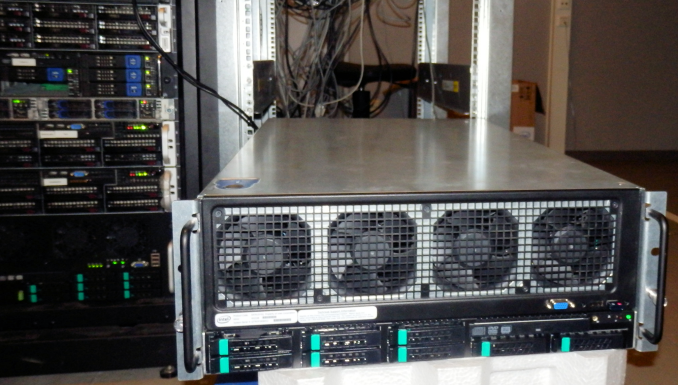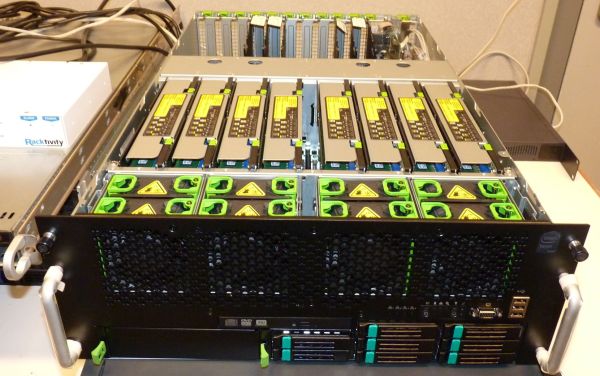The Intel Xeon E7-8800 v3 Review: The POWER8 Killer?
by Johan De Gelas on May 8, 2015 8:00 AM EST- Posted in
- CPUs
- IT Computing
- Intel
- Xeon
- Haswell
- Enterprise
- server
- Enterprise CPUs
- POWER
- POWER8
Benchmark Configuration
As far as reliability is concerned, while we little reason to doubt that the quad Xeon OEM systems out there are the pinnacle of reliability, our initial experience with Xeon E7 v3 has not been as rosy. Our updated and upgraded Quad Xeon Brickland system was only finally stable after many firmware updates, with its issues sorted out just a few hours before the launch of the Xeon E7 v3. Unfortunately this means our time testing the stable Xeon E7 v3 was a bit more limited than we would have liked.
Meanwhile to make the comparison more interesting, we decided to include both the Quad Xeon "Westmere-EX" as well as the "Nehalem-EX". Remember these heavy duty, high RAS servers continue to be used for much longer in the data center than their dual socket counterparts, 5 years or more are no exception. Of course, the comparison would not be complete without the latest dual Xeon 2699 v3 server.
All testing has been done on 64 bit Ubuntu Linux 14.04 (kernel 3.13.0-51, gcc version 4.8.2).
Intel S4TR1SY3Q "Brickland" IVT-EX 4U-server
The latest and greatest from Intel consists of the following components:
| CPU | 4x Xeon E7-8890v3 2.5 GHz 18c, 45 MB L3, 165W TDP or 4x Xeon E7-4890 v2 (D1 stepping) 2.8GHz 15 cores, 37.5MB L3, 155W TDP |
| RAM | 256 GB, 32x 8 GB Micron DDR-4-2100 at 1600MHz or 256 GB, 32x8GB Samsung 8GB DDR3 M393B1K70DH0-YK0 at 1333MHz |
| Motherboard | Intel CRB Baseboard "Thunder Ridge" |
| Chipset | Intel C602J |
| PSU | 2x1200W (2+0) |
Total amount of DIMM slots is 96. When using 64GB LRDIMMs, this server can offer up to 6TB of RAM.
If only two cores are active, the 8890 can boost the clockspeed to 3.3 GHz (AVX code: 3.2 GHz). The 4890v2 reaches 3.4 GHz in that situation. Even with all cores active, 2.9 GHz is possible (AVX code: 2.6 GHz).
Intel Quanta QSCC-4R Benchmark Configuration
The previous quad Xeon E7 server, as reviewed here.
| CPU | 4x Xeon X7560 at 2.26GHz, or 4x Xeon E7-4870 at 2.4GHz |
| RAM | 16x8GB Samsung 8GB DDR3 M393B1K70DH0-YK0 at 1066MHz |
| Motherboard | QCI QSSC-S4R 31S4RMB00B0 |
| Chipset | Intel 7500 |
| BIOS version | QSSC-S4R.QCI.01.00.S012,031420111618 |
| PSU | 4x850W Delta DPS-850FB A S3F E62433-004 850W |
The server can accept up to 64 32GB Load Reduced DIMMs (LR-DIMMs) or 2TB.
Intel's Xeon E5 Server – "Wildcat Pass" (2U Chassis)
Finally, we have our Xeon E5 v3 server:
| CPU | Two Intel Xeon processor E5-2699 v3 (2.3GHz, 18c, 45MB L3, 145W) |
| RAM | 128GB (8x16GB) Samsung M393A2G40DB0 (RDIMM) |
| Internal Disks | 2x Intel MLC SSD710 200GB |
| Motherboard | Intel Server Board Wilcat pass |
| Chipset | Intel Wellsburg B0 |
| BIOS version | August the 9th, 2014 |
| PSU | Delta Electronics 750W DPS-750XB A (80+ Platinum) |
Every server was outfitted with two 200 GB S3700 SSDs.












146 Comments
View All Comments
PowerTrumps - Saturday, May 9, 2015 - link
I'm sure the author will update the article unless this was a Intel cheerleading piece.name99 - Friday, May 8, 2015 - link
The thing is called E7-8890. Not E7-5890?WTF Intel? Is your marketing team populated by utter idiots? Exactly what value is there in not following the same damn numbering scheme that your product line has followed for the past eight years or so?
Something like that makes the chip look like there's a whole lot of "but this one goes up to 11" thinking going on at Intel...
name99 - Friday, May 8, 2015 - link
OK, I get it. The first number indicates the number of glueless chips, not the micro-architecture generation. Instead we do that (apparently) with a v2 or v3 suffix.I still claim this is totally idiotic. Far more sensible would be to use the same scheme as the other Intel processors, and use a suffix like S2, S4, S8 to show the glueless SMP capabilities.
ZeDestructor - Friday, May 8, 2015 - link
They've been using this convention since Westmere-EX actually, at which point they ditched their old convention of a prefix letter for power tier, followed by one digit for performance/scalability tier, followed by another digit for generation then the rest for individual models. Now we have 2xxx for dual socket, 4xxx for quad socket and 8xxx for 8+ sockets, and E3/E5/E7 for the scalability tier. I'm fine with either, though I have a slight preference for the current naming scheme because the generation is no longer mixed into the main model number.Morawka - Saturday, May 9, 2015 - link
man the power 8 is a beefy cpu... all that cache, you'd think it would walk all over intel.. but intel's superior cpu design winsPowerTrumps - Saturday, May 9, 2015 - link
please explaintsk2k - Saturday, May 9, 2015 - link
Where are the gaming benchmarks?JohanAnandtech - Saturday, May 9, 2015 - link
Is there still a game with software rendering? :-)Gigaplex - Sunday, May 10, 2015 - link
Llvmpipe on Linux gives a capable (feature wise) OpenGL implementation on the CPU.Klimax - Saturday, May 9, 2015 - link
Don't see POWER getting anywhere with that kind of TDP. There will be dearth of datacenters and other hosting locations retooling for such thing. And I suspect not many will even then take it as cooling and power costs will be damn too high.Problem is, IBM can't go lower with TDP as architecture features enabling such performance are directly responsible for such TDP. (Just L1 consumes 2W to keep few cycles latency at high frequency)